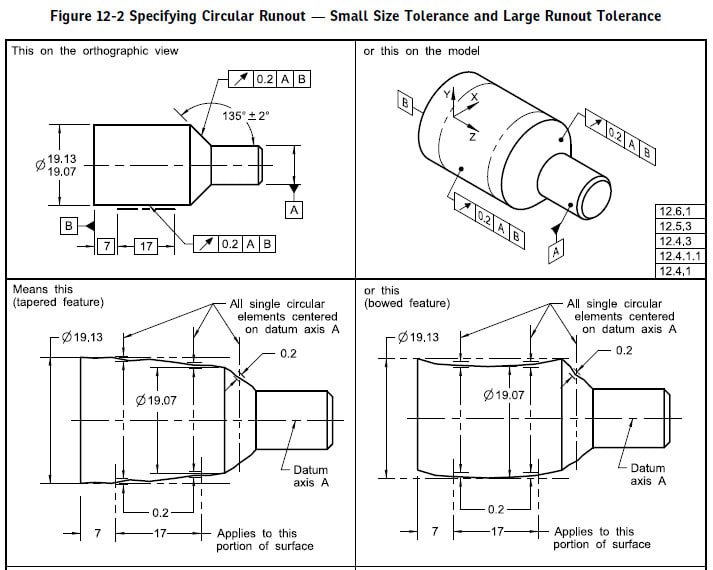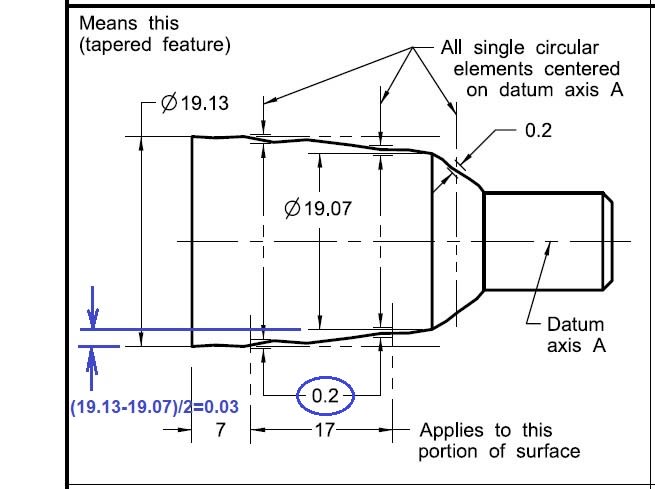Navigation
Install the app
How to install the app on iOS
Follow along with the video below to see how to install our site as a web app on your home screen.
Note: This feature may not be available in some browsers.
More options
Style variation
-
Congratulations TugboatEng on being selected by the Eng-Tips community for having the most helpful posts in the forums last week. Way to Go!
You are using an out of date browser. It may not display this or other websites correctly.
You should upgrade or use an alternative browser.
You should upgrade or use an alternative browser.
How to read "Means this"?
- Thread starter SeasonLee
- Start date
- Status
- Not open for further replies.
There is no use specifying datum reference B; no idea why that was seen as required; a plus-minus directly toleranced dimension would serve just as well. And it doesn't affect the sloped surface feature control frame at all.
Both specify datum reference A, which makes centers meaningless to verifying the requirement.
It still suffers the flaw that the much larger runout tolerance range is shown as much smaller than the size tolerance. It's sloppy work that misrepresents the situation and, by showing nearly no runout on the tapered version, when the runout is much larger than the size tolerance, is worse.
Both specify datum reference A, which makes centers meaningless to verifying the requirement.
It still suffers the flaw that the much larger runout tolerance range is shown as much smaller than the size tolerance. It's sloppy work that misrepresents the situation and, by showing nearly no runout on the tapered version, when the runout is much larger than the size tolerance, is worse.
mfgenggear
Aerospace
@3DDave
in gear & grind shops use manufacturing equipment that utilizes centers.
and inspection equipment that utilizes centers, it is essential to allow manufactures to use centers.
these are parts that have tight and less than .0005 in size and total runout requirements for
bearing journals , and or gear and spline requirements for tight Pitch Diameter Runout.
basically shafts with tight engineering requirements.
it makes grinding outside diameters and gears simpler.
if the case of "mean this " It would be optional centers for clearly that example part of no heat treat
requirement it could be easily turned to the specified requirements.
I trying in vain to communicate what if situation.
in gear & grind shops use manufacturing equipment that utilizes centers.
and inspection equipment that utilizes centers, it is essential to allow manufactures to use centers.
these are parts that have tight and less than .0005 in size and total runout requirements for
bearing journals , and or gear and spline requirements for tight Pitch Diameter Runout.
basically shafts with tight engineering requirements.
it makes grinding outside diameters and gears simpler.
if the case of "mean this " It would be optional centers for clearly that example part of no heat treat
requirement it could be easily turned to the specified requirements.
I trying in vain to communicate what if situation.
- Thread starter
- #23
My understanding is: A single cylindrical feature can be used to establish an axis when it is long enough to orient the part, if the cylindrical feature is not long enough(as shown on this case) to orient the part, then we need a secondary datum feature to orient/locate the part, so in this way we will have a repeatable datum axis in measurement.3DDave said:There is no use specifying datum reference B
This is where I still can't image how the runout will effect the form in this case.3DDave said:It still suffers the flaw that the much larger runout tolerance range is shown as much smaller than the size tolerance. It's sloppy work that misrepresents the situation and, by showing nearly no runout on the tapered version, when the runout is much larger than the size tolerance, is worse.
Season
They cannot compete to see which is more orientation-controlling. If datum feature A is too small to control orientation then datum feature B should be primary.
As to the second part - me neither. It's not what I wrote, so is this agreement??
As to the second part - me neither. It's not what I wrote, so is this agreement??
mfgenggear
Aerospace
agreed,
no mater what the requirement of .02 runout has to be held, the mfg is therefore forced to hold tighter form requirements of the 19.13 diameter.
because otherwise it will not hold the engineering requirement. and this is often done.
the diameter can be between tolerance of the diameter with form that maintains the runout.
no mater what the requirement of .02 runout has to be held, the mfg is therefore forced to hold tighter form requirements of the 19.13 diameter.
because otherwise it will not hold the engineering requirement. and this is often done.
the diameter can be between tolerance of the diameter with form that maintains the runout.
Burunduk
Mechanical
- May 2, 2019
- 2,580
The contraction on A will stop on datum feature A.
Rotational degrees of freedom will be constrained by A and B together if A alone is unable to constrain them properly. It will be simulated the same way as in the original version but the |A-B| specification may represent what happens better. B as secondary doesn't constrain any meaningful DOF for runout on the cylindrical feature.
Rotational degrees of freedom will be constrained by A and B together if A alone is unable to constrain them properly. It will be simulated the same way as in the original version but the |A-B| specification may represent what happens better. B as secondary doesn't constrain any meaningful DOF for runout on the cylindrical feature.
I agree that as currently shown "B" brings nothing to the callout. If "B" is primary than I see some value added concept.
I think A-B is a valid approach in ISO GPS, but no so much in ASME.
In ASME I've never seen this A-B in any on their drawings (A and B in depicted scheme)
I think A-B is a valid approach in ISO GPS, but no so much in ASME.
In ASME I've never seen this A-B in any on their drawings (A and B in depicted scheme)
Burunduk
Mechanical
- May 2, 2019
- 2,580
greenimi,
For a scheme to be valid it is not required that an example duplicating the exact case is shown in the figures.
The text supports it.
From the 2009 standard:
"4.12 MULTIPLE DATUM FEATURES
Where more than one datum feature is used to establish a datum feature simulator for a single datum, the appropriate datum feature reference letters and associated
modifiers, separated by a dash, are entered in one compartment of the feature control frame."
The datum axis will be derived from a simulator constructed by a component with a planar face for datum feature B to be supported against and another component with a contracting chuck the axis of which is normal to the planar face. Datum |A-B| is an axis and a plane at a right angle to it. We know that a "single datum" is not always only an axis or only a plane, because there are datum features that establish a combination of plane+axis or plane+axis+point, as indicated by the table in fig. 4-3. The combination of axis+plane I described will be established by the simulator of datum feature |A-B|.
Let me know if you still think it's invalid, and why.
For a scheme to be valid it is not required that an example duplicating the exact case is shown in the figures.
The text supports it.
From the 2009 standard:
"4.12 MULTIPLE DATUM FEATURES
Where more than one datum feature is used to establish a datum feature simulator for a single datum, the appropriate datum feature reference letters and associated
modifiers, separated by a dash, are entered in one compartment of the feature control frame."
The datum axis will be derived from a simulator constructed by a component with a planar face for datum feature B to be supported against and another component with a contracting chuck the axis of which is normal to the planar face. Datum |A-B| is an axis and a plane at a right angle to it. We know that a "single datum" is not always only an axis or only a plane, because there are datum features that establish a combination of plane+axis or plane+axis+point, as indicated by the table in fig. 4-3. The combination of axis+plane I described will be established by the simulator of datum feature |A-B|.
Let me know if you still think it's invalid, and why.
Burunduk said:The datum axis will be derived from a simulator constructed by a component with a planar face for datum feature B to be supported against and another component with a contracting chuck the axis of which is normal to the planar face. Datum |A-B| is an axis and a plane at a right angle to it. We know that a "single datum" is not always only an axis or only a plane, because there are datum features that establish a combination of plane+axis or plane+axis+point, as indicated by the table in fig. 4-3. The combination of axis+plane I described will be established by the simulator of datum feature |A-B|.
Let me know if you still think it's invalid, and why
Definitely I would say this in uncharted territory for ASME. I do not think this is the way Y14.5 committee envision usage of common datum feature primary A-B.
Even in ISO GPS the way to use A-B in this context is not very common and there are ISO users/ experts uncomfortable with the interpretation.
Burunduk
Mechanical
- May 2, 2019
- 2,580
greenimi said:I do not think this is the way Y14.5 committee envision usage of common datum feature primary A-B.
As far as I know, the intended use of a common datum feature/multiple datum feature is to have 2 features or more labeled with datum feature symbols of different letters constraining the same degrees of freedom together without precedence of one over the other. I can't see how this case is outside of the concept. The only drawback is lack of an example/figure but as I mentioned what matters is that it can be interpreted per the paragraphs. Other than ISO experts' opinions, are there any specific ambiguities you recognize when the scheme is interpreted per ASME? What part of it may make the drawing user who works per the standard stumped?
- Status
- Not open for further replies.
Similar threads
- Locked
- Question
- Replies
- 4
- Views
- 389
- Replies
- 22
- Views
- 2K
- Question
- Replies
- 17
- Views
- 7K
- Locked
- Question
- Replies
- 2
- Views
- 403


